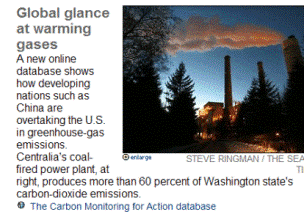My head is about to explode from reading this newspaper article.
The article includes a lengthy “explanation” of climate fairness from Duke Energy. But it doesn’t bother to point out to readers that the reasoning is just, you know, completely false.
…[Duke Energy Chairman James Rogers] would oppose any effort to auction off carbon allowances… That could raise rates for Duke’s Indiana customers by 35 percent by 2012, Rogers said, and amounts to a tax.
“The whole point of cap-and-trade is to put a price on carbon so we can make good economic decisions in the future,” he said. “It’s not about punishing people for making decisions 40 years ago.”
Yep, that Duke Energy sure is looking out for the little guy.
Oh wait, what’s that?
Duke actually supports cap-and-trade? But they want carbon permits handed out to them for free?
And you say that handing out free carbon permits raises prices for consumers every bit as much as auctioning? But with free permits Duke would make gigantic windfall profits? And the windfall would be funded by consumers?
Say it ain’t so!
Okay, I know this carbon pricing stuff is complicated. But it matters. A lot. So reporters need to get up to speed with a quickness.
The impact on consumer prices is the same whether the permits are auctioned or handed out for free. The only difference is who benefits: the public or polluters. And Duke’s claim is so wildly misleading—and so baldly cynical—that it’s just bad journalism not to provide a counterpoint.
But that wasn’t the only thing that made me crazy.
All morning today, the Seattle Times’ front page teaser for the article (below) claimed that the Centralia coal plant emits 60 percent of Washington’s CO-2.
But this is not even close. Centrail’s emissions are only about 11 percent of Washington’s total. Data is here (pdf).
Argh.










Clark Williams-Derry
Ouch. My brain just blew up. Thanks a lot, Duke Energy!
eldan
Unfortunately, I think you’re going to find yourselves responding to a lot of equivalents to that Duke Energy BS, as companies recognise that something will be done to put a price on emissions, and try to make sure it’s the something that fits their particular interests.As for the second item, I wonder where that statistic came from. Is it possible that the Centralia plant is responsible for 60% of this state’s GHG emissions from electricity generation?
Eric de Place
Two good points, Eldan. (In fact, I’m updateding the post to make it clearer in light of your comment.)On the first, I’m happy that Duke is supporting a firm cap on emissions. And it’s only natural that they’ll try to make a quick buck on the deal. I just wish the press wouldn’t play patsy for arguments that are clearly misleading.Your 60% hunch is a good one. I did some noodling this morning along those lines but I could find it. Total electricity generation was my first hunch too, but it’s only about 20% (b/c most of our power is clean hydro). I’ve run the numbers a bunch of different ways and I just can’t figure out how they landed on 60%.
Clark Williams-Derry
Eldan, I think you’re right. As of 2004, Centralia was about 56 percent of total emissions from the states electricity generation portfolio—but only when you count net electricity imports. This, via the GHG accounting done by WA CTED (a state agency), available here.
Eric de Place
Oh… I’m slow today. You’re saying that maybe Centralia is 60% of WA’s electricity emissions. Right. (I misread and thought you were suggesting that electricity was responsible for 60% of WA’s total emissions.)
MichelleV.P.
I’m totally not a number’s geek! So, I’m always grateful when you geek-a-holics gather round to make sense of mind-blowing data, and explain it to those of us who have more moderate data-tastes. But do take care of your heads, please 🙂